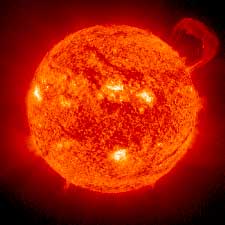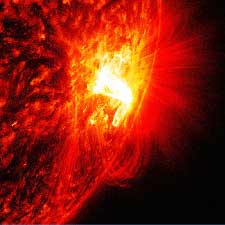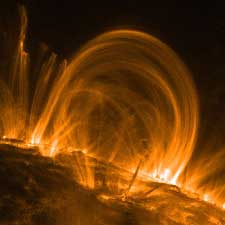The Sun
The Sun is by far the largest and brightest object in our solar system. If you were to compare the mass of the Sun with all other objects in our solar system it would contain 98.8% of the mass of the whole solar system. To put that into context the Sun is so huge you could fit around 1 million planet Earth’s inside the Sun.
The Sun is a star which is at the centre of our solar system as is categorised as a yellow dwarf star. Our Sun is essentially a ball of gas that is held together by its own gravity. Each of the planets in our solar system orbit around the Sun (travel around the Sun) and it is responsible for being able to support life on Earth, and drives the seasons, climate and weather systems on our planet.
The Sun is an almost perfect sphere which is made up of ionized gas (mostly hydrogen with some helium). The average radius of the Sun is 695,800 km (this is 109 times larger than the diameter of the Earth) and on the surface of the Sun the temperature can reach 10,000 degrees Celsius. Unbelievably, if you were able to delve into the depths of the Sun the temperature would rise to in excess of 15 million degrees Celsius!
The position of the Sun
The Sun is at the centre of our solar system. All of the planets in our solar system travel in orbit around the Sun. The further the planet is away from the Sun the longer it will generally take the planet to complete a full orbit of the Sun. For example, the Earth takes 365 days to complete a full circle (or orbit) of the Sun, whilst Neptune (the furthest planet from the Sun in our solar system) takes 165 years to complete a full orbit!
Although the Sun is the closest star to our planet it is one of many stars. Our solar system is within the Milky Way galaxy and it is estimated that there are around 300 billion stars in the Milky Way – of which our Sun is only one. All of the Suns in our galaxy orbit the galactic centre – our Sun is within the inner rim of the Orion Arm of the Milky Way and it will take approximately 225–250 million years to complete one full galactic orbit.
Solar eclipse
Solar eclipses occur when the Moon is aligned between the Earth and the Sun which blocks out sunlight to the Earth and for a short time darkness will descend on the side of the Earth that will normally have light. Solar eclipses only happen once ever one or two years and do not last for more than seven or eight minutes.
The eclipse will start when a portion of the Moon is covering the Sun. The shadow will begin to creep further across the Sun so that during a period called “totality” the whole Sun will be covered so that only the corona would be viewable (the corona is the outer atmosphere of the Sun which has a shimmering effect and is rarely possible to see).
Total eclipses are rare and are only possible due to the strange co-incidence that from the surface of the Earth both the Moon and the Sun look to be exactly the same size. This is of course not true as each celestial body is of a significantly different size and distance away from the Earth.
Sun Facts
The Sun is approximately 4.6 billion years old.
Over the ages many religions and civilisations have worshipped the Sun and treated it with mythical reverence. There are numerous monuments and structures around the world that were built based on the location of the Sun or to worship a Sun god. It is possible that a monument such as Stonehenge in the UK was created as an ancient solar monument.
Different cultures refer to the Sun by different names. The ancient Greeks called it Helios, whilst the Romans called it Sol, which we translated into Sun.
The diameter of the Sun is 1,391,684 kilometres.
The Sun travels through space at about 220 kilometres per second.
By calculating the speed of light, it takes approximately 8 minutes for sunlight from the Sun to hit the Earth.
The Sun creates solar winds that can escape the star and extend through space at 450 kilometres per second.
It is believed that the Sun is heating up over time. Every billion years the Sun increases in luminosity by 10%. This means that in a billions years’ time, the water on the Earth could have dried up due to increased heat from the Sun which would lead to the eradication of life on Earth. After 5 billion years it is believed that the Sun will change from being a yellow dwarf to a red dwarf which will mean the Sun will swell in size and consume the inner terrestrial planets in our solar system (the Earth included) and eventually turn into a white dwarf.
Never look directly at the Sun as the UV light is extremely destructive to your eyes and could lead to permanent eye damage.
Figures and Statistics
| The Sun | Earth | Ratio (Sun to Earth) | |
| Rotation period - (hours) | 609.12 | 23.9345 | 25.449 |
| Radius (km) | 695800 | 6378.1 | 109.092 |
| Mass (1024 kg) | 1988500 | 5.9726 | 333000 |
| Volume (1011 km3) | 1412000 | 108.321 | 1304000 |
| Density (kg/m3) | 1408 | 5514 | 0.255 |
| Distance from Earth - Min (106km) | 147.1 | - | - |
| Distance from Earth - Max - (106km) | 152.1 | - | - |
| Surface gravity (m/s2) | 274 | 9.81 | 28 |
| Surface temp - Average (K) | 5778 | 330 | 17.509 |
-
Notes on the above figures:
- Orbits are invariably elliptical in nature. The average distance from the sun that appears above is also known as a 'semi-major axis', which is the mean (average) radius of the elliptical orbit.
- Axial tilt is also known as 'obliquity to orbit' and is the angle of rotation of the body itself with an imaginary line drawn through both poles, relative to its plane of orbit.
- Radius figures quoted are equatorial measurements. As most bodies exhibit 'oblateness' - that is to say that they appear slightly squashed - the radius from the centre to the poles would invariably be shorter.
- The Kelvin temperature scale is used for all temperature measurements above. 0K is equivalent to -273.15°C (degrees Celsius). To convert from K to C, simply subtract this figure from the Kelvin temperature given.
- Use of 'Index Notation' for very large numbers as above can be explained as follows; 106 = 10 x 10 x 10 x 10 x 10 x 10, or 1,000,000. For example, if you see a number that appears as 6x1011 then that number written in full would be 6 x 10 x 10 x 10 x 10 x 10 x 10 x 10 x 10 x 10 x 10 x 10 - or 600,000,000,000. Index notation allows us to write very big (or very small) numbers down far more concisely.


